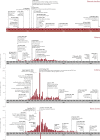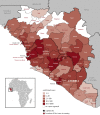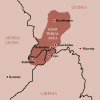The Ebola outbreak, 2013-2016: old lessons for new epidemics
- PMID: 28396469
- PMCID: PMC5394636
- DOI: 10.1098/rstb.2016.0297
The Ebola outbreak, 2013-2016: old lessons for new epidemics
Abstract
Ebola virus causes a severe haemorrhagic fever in humans with high case fatality and significant epidemic potential. The 2013-2016 outbreak in West Africa was unprecedented in scale, being larger than all previous outbreaks combined, with 28 646 reported cases and 11 323 reported deaths. It was also unique in its geographical distribution and multicountry spread. It is vital that the lessons learned from the world's largest Ebola outbreak are not lost. This article aims to provide a detailed description of the evolution of the outbreak. We contextualize this outbreak in relation to previous Ebola outbreaks and outline the theories regarding its origins and emergence. The outbreak is described by country, in chronological order, including epidemiological parameters and implementation of outbreak containment strategies. We then summarize the factors that led to rapid and extensive propagation, as well as highlight the key successes, failures and lessons learned from this outbreak and the response.This article is part of the themed issue 'The 2013-2016 West African Ebola epidemic: data, decision-making and disease control'.
Keywords: Ebola; Ebola outbreak; Ebola virus disease; West Africa.
© 2017 The Authors.
Conflict of interest statement
A.M.J. is a governor of the Wellcome Trust. The authors have no other conflicts of interest to declare.
Figures




References
-
- WHO. 2016. Ebola virus disease fact sheet. http://www.who.int/mediacentre/factsheets/fs103/en/ (accessed 15 December 2016).
-
- Dowell SF, Mukunu R, Ksiazek TG, Khan AS, Rollin PE, Peters CJ. (Commission de Lutte contre les Epidemies a Kikwit). 1999 Transmission of Ebola hemorrhagic fever: a study of risk factors in family members, Kikwit, Democratic Republic of the Congo, 1995. J. Infect. Dis. 179(Suppl. 1), S87–S91. ( 10.1086/514284) - DOI - PubMed
-
- CDC. 2016. About Ebola virus disease. https://www.cdc.gov/vhf/ebola/about.html (accessed 15 December 2016).
-
- WHO. 2016. Ebola situation reports: archive. http://www.who.int/csr/disease/ebola/situation-reports/archive/en/ (accessed 9 October 2016).
Publication types
MeSH terms
LinkOut - more resources
Full Text Sources
Other Literature Sources
Medical
